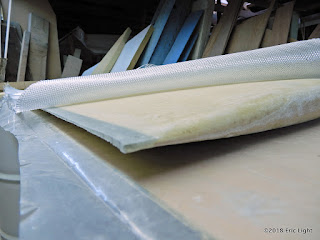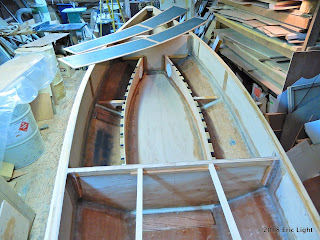I applied a layer of glass to one side of the board, wrapping around the forward edge and trailing past the after edge, which I had cut the point off of. When that first layer was hard, I turned the board over and filled in the point of the trailing edge with chopped glass strand in resin (which John makes himself, and calls "goop"):
After the goop was hard, I cut the ragged part off, then ground the rest in the shape of the point of foam I'd cut off. More or less.
Then I glassed the second side, over the gooped "point". So the board's fine trailing edge will be all fibreglass, to withstand whatever hits it might endure and not get chunks taken out. The point will be ground and filled as necessary to even it all out.
Meanwhile, I've worked up a mast partner. I'll wait till I've made the mast before finishing it, so the hole will be sized right. I was going to make the mast ¼" larger than what the plans call for (hence the pencil line around the hole), but I may just do it per plan.
The upper board guard is made with three layers of the ¼" mahogany ply. I laminated it in the position it will end up in, just under the gunnel, so it has the same slight curve as the sheer:
I'll cut the slot out when the board is finished, so I know the exact width.
And... here's what the hatch cover mold looks like so far:































